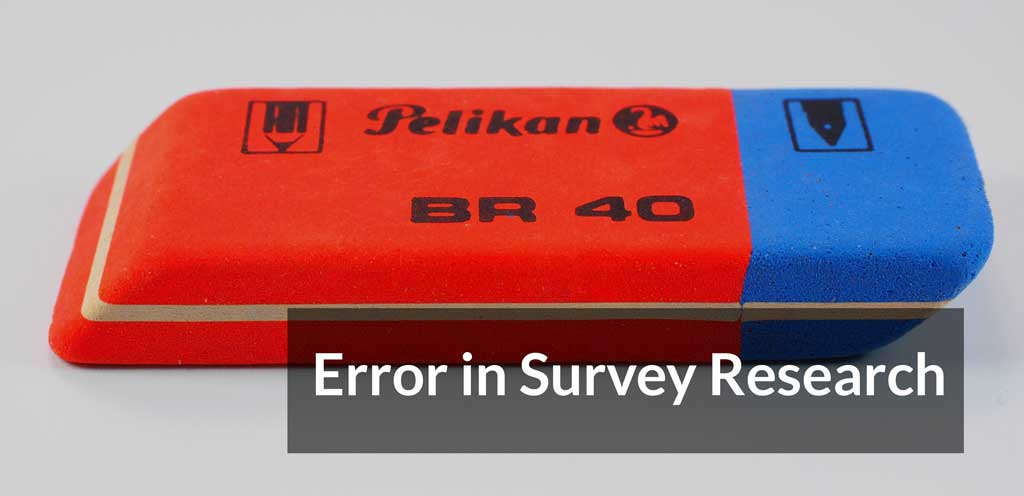In survey research, it is common to have errors. Survey errors may arise from different sources. Broadly, we can classify these errors into two types.
Types of error in survey research:
A. Random Sampling Error in survey research:
Generally, a survey is done based on the sample. But it is not possible that the sample will be fully representative of the population. As a result, an error will occur such error is known as sampling error or random sampling error. In other words, using sample rather than population results in errors which are known as sampling errors.
This error is obvious & can’t be eliminated unit a large sample or the whole population is being studied. Different statistical techniques are used to determine the significance of the errors.
B. Systematic error/Non-sampling error:
The other major source of survey error, systematic error, results from some imperfect aspect of the research design or from a mistake in the execution of the research design or from a mistake in the execution of the research. The many
- Respondent error
- Administrative error
1. Respondent error:
Surveys ask people for answers. If people co-operate and give truthful answers, a survey will likely accomplish its goal. If these conditions are not met, the two major categories of respondent
- Non-response error in survey research
- Response Bias
non response error in survey research
Few surveys have 100 percent response rates. In fact, surveys with relatively low response
Response Bias:
A response bias occurs when respondents tend to answer questions with a certain slant people may consciously or unconsciously misrepresent that truth. When researchers identify response bias, they should include a corrective measure response bias may occur in the following ways:
- Deliberate Falsification: Occasionally people deliberately give
false answer. It is difficult to assess why people knowingly misrepresent answers.A response bias may occur when people misrepresent answer to appear intelligent, conceal personal information, avoid embarrassment, and so on. For example, respondents may be able to remember the total amount of money spent on grocery shopping, but they any forget the exact prices of individual items that they purchased. - Unconscious Misrepresentation: Even when a respondent is consciously trying to be truthful and cooperative, response bias can arise from the question format the question content, or some other stimulus, For example, bias can be introduced by the situation in which the survey is administered.
- Types of Response Bias: Response bias falls into four specific categories acquiescence bias, extremity bias interviewer bias, and social desirability bias. These categories overlap and are not mutually exclusive.
- Acquiescence Bias: Some respondents are very agreeable. They seem to agree to practically every statement they are asked about. A tendency to agree (or disagree) with all or most questions is known
is acquiescence bias. This bias is particularly prominent in new product research. - Extremity Bias:Some people tend to use extremes once responding to queries. for instance, they will opt for solely “1” or “10 on a ten-point scale. Others consistently refuse to use extreme positions and tend to respond more neutrally “I never give a 10 because nothing is really perfect. Response styles vary from person to person, and extreme responses may cause an extremity bias in the data.
- Interviewer Bias: Response bias might arise from the interaction between querier and respondent. If the interviewer’s presence influences respondents to give untrue or modified answers, the survey will be marked by interviewer bias. Many homemakers and retired people welcome an interviewer’s visit as a break in routine activities. Other respondents may give answers they believe will please the interviewer rather than the truthful response.
- Social Desirability Bias: Social desirability bias might occur either consciously or unconsciously as a result of the respondent desires to make a good impression or save face within the presence of AN enquirer. Incomes may be inflated, education overstated, perceived respectable answers given to gain prestige.
02. Administrative error:
The results of improper administration or execution of the analysis task are termed Associate in Nursing body error. Administrative errors are caused by carelessness, confusion, neglect, omission, or some other blunder. Four types of administrative errors are data-processing selection error, interviewer error, and interviewer cheating.
- Data processing error: Processing data by computer, like any arithmetic or procedural process, is subject to error because data must be edited, coded, and entered into the computer by people. The accuracy of data processed by
computer depends on correct data entry and programming. - Sample selection error: Many kinds of error involve
failure to select a representative sample. Sample choice error issystematic error that ends up in Associate in Nursing untypical sample owing to a slip-up in either the sample style or the execution of the sampling procedure. - Interviewer error: Interviewers’ abilities
very considerably. Interviewer error is introduced when interviewers record answers but check the wrong response or are unable to write fast enough to record answers verbatim. - Interviewer or cheating: Interviewer cheating occurs when an interviewer falsifies entire questionnaires or fills in answers to questions that have been intentionally skipped.
If interviewers are suspected of faking questionnaires, they should be told total that a small percentage of respondents will be called back to confirm whether the initial interview was actually conducted. This practice should discourage interviewers from cheating.





Greetings, I do think your blog may be having internet browser compatibility problems.
When I look at your website in Safari, it looks fine but when opening in I.E.,
it has some overlapping issues. I simply wanted to
give you a quick heads up! Apart from that, fantastic site!